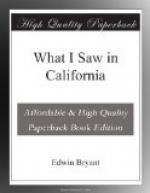Presuming a statistical knowledge of this country, before and after the missionary institutions were secularized, may be interesting, I will insert the following returns of 1831 and 1842, to contrast the same with its present condition:—
1st. In 1832 the white population throughout Alta-California did not exceed 4,500, while the Indians of the twenty-one missions amounted to 19,000; in 1842, the former had increased to 7,000, and the latter decreased to about 5,000.
2nd. In the former year, the number of horned cattle, including individual possessions, amounted to 500,000; in the latter, to 40,000.
3rd. At the same period, the number of sheep, goats, and pigs, was 321,000; at the latter, 32,000.
4th. In 1831 the number of horses, asses, mules, etc., was 64,000; in 1842 it was 30,000.
5th. The produce in corn, etc., had decreased in a much greater proportion—that of seventy to four.
The amount of duties raised at the customhouse in Monterey, from 1839 to 1842, was as follows, viz.:—
1839 85,613 dollars. 1840 72,308 dollars 1841 101,150 dollars 1842 73,729 dollars.
The net amount of revenue seldom exceeding in any year eighty thousand dollars; so that, when a deficiency took place, to supply the expenditures of government, it had been usual to call upon the missions for aid.
The value of the hides and tallow derived from the annual matanzas may be estimated at 372,000 dollars. These two commodities, with the exception of some beaver, sea-otter, and other furs, comprise the most important part of the exportations, which in addition, would augment the value of exports to 400,000 dollars.
The permanent population of that portion of Upper California situated between the Sierra Nevada and the Pacific, I estimate at 25,000. Of this number, 8,000 are Hispano-Americans, 5,000 foreigners, chiefly from the United States, and 12,000 christianized Indians. There are considerable numbers of wild or Gentile Indians, inhabiting the valley of the San Joaquin and the gorges of the Sierra, not included in this estimate. They are probably as numerous as the Christian Indians. The Indian population inhabiting the region of the Great Salt Lake, Mary’s River, the oases of the Great Desert Basin, and the country bordering the Rio Colorado and its tributaries, being spread over a vast extent of territory, are scarcely seen, although the aggregate number is considerable.
The Californians do not differ materially from the Mexicans, from whom they are descended, in other provinces of that country. Physically and intellectually, the men, probably, are superior to the same race farther south, and inhabiting the countries contiguous to the city of Mexico. The intermixture of blood with the Indian and negro races has been less, although it is very perceptible.




